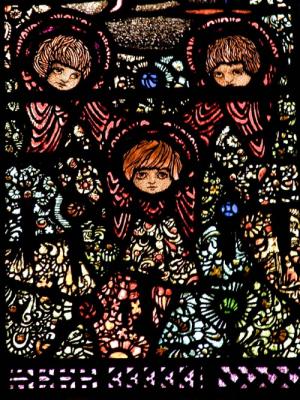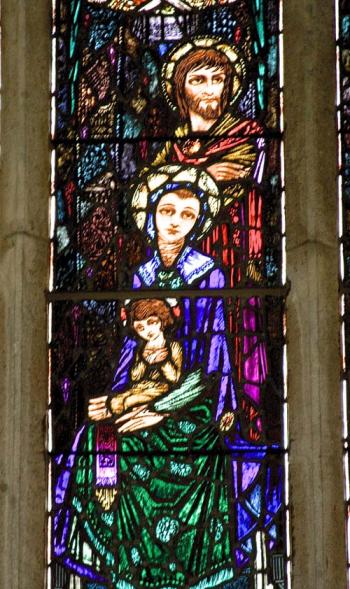November 30, 2012
By Judy Enright
Special to the BIR
 It’s hard to fully appreciate the amazing colors and complex details in the late artist Harry Clarke’s magnificent stained glass windows The Immaculate Conception window (1925) in St. Mary’s in Ballinrobe, Co. Mayo. (Judy Enright photo)
It’s hard to fully appreciate the amazing colors and complex details in the late artist Harry Clarke’s magnificent stained glass windows The Immaculate Conception window (1925) in St. Mary’s in Ballinrobe, Co. Mayo. (Judy Enright photo)
It seems appropriate in this holiest of seasons to draw special attention to the incredibly detailed and brilliant stained glass windows designed and created by Irish artist Harry Clarke at the beginning of the 20th Century.
Clarke was born on St. Patrick’s Day 1889 on North Frederick Street, Dublin, where his father, Joshua, had a stained glass and ecclesiastical decorating business. The younger of two sons (brother Walter was exactly one year older), Harry left school at 14 to join the family business after his mother, Bridget, died. He took night classes in stained glass and won several scholarships, which ultimately led him to study the art in London and France.
If you have visited Ireland numerous times but have never heard of Harry Clarke or seen his windows, don’t worry. Many are in remote churches and, honestly, I only happened upon his work a few years ago after someone told me about a pastor who sold his life insurance to pay for stained glass windows in his church. Canon Michael MacDonald, a seemingly colorful character and pastor of St. Patrick’s Church in Newport, Co. Mayo, sold his policy for the magnificent windows that he commissioned in 1926. Clark apparently visited the church and found the canon out in his rose garden, carrying a basket and wearing a large straw hat, and was completely charmed by him.
As a side note, MacDonald is also credited, along with Dr. John Healy, archbishop of Tuam, with building the oratory at the top of nearby 2,510-foot high Croagh Patrick in Murrisk where St. Patrick is said to have fasted for 40 days and nights in the 5th Century. The oratory was dedicated on July 20, 1905, and re-established the ancient pilgrimage on Reek Sunday, the last Sunday in July. Depending on the weather, some 25,000 climb the mountain that day, many barefooted, to honor the memory of St. Patrick’s fast and do penance for their sins. Mass is celebrated on the summit every half hour from 8 a.m. to 2 p.m. that day.
‘Last Judgment’ in Newport
The finely detailed Last Judgment window over the high altar in the east wall of St. Patrick’s in Newport took four years to complete and has been described as Clarke’s most magnificent accomplishment and “a complete revelation in stained glass work.” The window includes a self-portrait of an anguished Clarke, said to portray his prolonged suffering from poor health.
A dedicated artist, Clarke continued working on the Newport design even while confined to a Swiss sanatorium where doctors worked to curb the tuberculosis in both lungs. He died in 1931 at the age of 41 en route home to Ireland and a month before his studio installed the final window in St. Patrick’s.
Clarke was commissioned during his short lifetime to create more than 160 windows for religious and commercial entities and was also well known as an illustrator. Among his more famous illustrations were the drawings in two editions of the works of Edgar Allan Poe.
 Detail of The Adoration of the Magi (1925) stained glass window in St. Patrick’s Church, Kilmaine, Co. Mayo, shows the brilliance of the late stained glass artist Harry Clarke
Detail of The Adoration of the Magi (1925) stained glass window in St. Patrick’s Church, Kilmaine, Co. Mayo, shows the brilliance of the late stained glass artist Harry Clarke
It’s interesting that Clarke and his brother, Walter, were born on March 17 a year apart, worked in the family stained glass business, married sisters – Margaret and Minnie Crilley from Louth – and died within six months of one another.
Clarke works in the US
Also interesting is that Harry was commissioned to do nine windows for the Basilica of St. Vincent de Paul in Bayonne, N.J., which he insisted on designing and personally supervising even though that work was done during the last year of his life.
And, if you happen to visit the Wolfsonian–Florida International University design museum in Miami, FL, be sure to look in the permanent collection for his Geneva Window –13 panels each recording an incident or scene from Irish literature. The window was originally commissioned for the League of Nations in 1931 but was rejected by the prudish Irish government. You can also find Harry Clarke windows in buildings in Australia, England, Northern Ireland, Scotland and Wales.
Several books have been written about Clarke and his work. Nicola Gordon Bowe wrote the comprehensive “The Life and Work of Harry Clarke,” first published in 1989 with a paperback edition in 1994, and “Strangest Genius: Stained Glass of Harry Clarke,” by Lucy Costigan and Michael Cullen, published in 2010.
Mayo Co. Council offers guide …
The Mayo County Council published an excellent guide to Harry Clarke windows in 17 Mayo churches as part of the County Mayo Heritage Plan 2006-2011. I was surprised, after visiting St. Mary’s Church in Ballinrobe and St. Patrick churches in Newport, Kilmaine, and Lahardaun, that there’s no literature in any of them about the windows or Clarke. Visitors, when we were there, clearly knew about Clarke and his work and had made a point to visit and photograph the windows.
Wrote Bowe in her foreword to the Co. Mayo booklet: “The initiative of the Mayo County Council, under the able direction of its Heritage Officer, Dr. Deirdre Cunningham, is to be congratulated in realizing this beautifully illustrated account in their county of windows by an outstandingly brilliant Irish artist and his studio. Two similarly extraordinary Mayo parish priests, Canon MacDonald of Newport and Monsignor Thomas Shannon of Ballinrobe, passionate supporters of Harry Clarke’s unique achievement in stained glass, are among those who would be proud of this laudable venture, having done so much to encourage and foster interest in it.” Lovely photos as well as the design and layout for the Mayo brochure were by Michael McLaughlin Studios of Westport.
We were able to purchase a copy of the Clarke booklet at the Mayo County Council offices on the Mall, near the Garda station in Castlebar, where the front lobby staff could not have been more helpful or accommodating. They are a credit to their organization.
We heard that the booklets are also availlable at Seamus Duffy’s Bookshop in Westport and no doubt in bookshops in Castlebar and elsewhere throughout Mayo. It’s well worth purchasing and visiting the varied churches if you have the chance. You will quickly see which windows are Harry Clarke’s and which are not. His designs, colors ,and details are remarkable and easily identifiable.
… and a desk calendar
The County Council also produced a beautiful 2012 desk calendar with photos of churches and abbeys on the Ecclesiastical Heritage Trail of County Mayo. Photos again by Michael McLaughlin Studios, as well as by Eamonn McCarthy. It is wonderful to see how much the Irish, especially in Mayo, appreciate their amazing treasures and we can hardly wait to see what the Mayo county council produces next!
Michelin stars: South Dublin and Galway city restaurants recently became 2013 Michelin Star recipients. Cited were: Locks Brasserie in Portobello, Dublin, a French restaurant and sister restaurant of Pearl Brasserie, and Aniar, at Lower Dominick Street, Galway.
Aniar is owned and operated by Jp McMahon and Drigín Gaffey, who started Cava Spanish Restaurant and Tapas Bar, and is the only Michelin Star restaurant in the West of Ireland. The Patrick Guilbaud restaurant in Dublin is the only Irish restaurant with two stars. Sebastien Masi owns both Dublin Brasseries.
Those who say Irish food hasn’t changed in 30 years need only stop by for a meal at any of those great restaurants or at many other excellent pubs and restaurants all over the country. Irish food has definitely changed – for the better!
Guidebook writer Georgina Campbell also issues annual awards. Restaurant of the Year (tastiest and friendliest) for 2012 went to The Greenhouse in Dublin. Chef of the year was Ian Orr from Brown’s Restaurant in Derry, Northern Ireland, and Hotel of the Year was The Granville Hotel in Waterford.
Campbell’s Pub of the Year was Nancy’s Bar in Ardara, Co. Donegal, and having eaten lunch there – the freshest and tastiest fish, well prepared and served – I can vouch for that one and also for breakfasts at the Quay House in Clifden, Co. Galway, where I stayed several years ago. Quay House won the Guesthouse Breakfast Award from Campbell.
Holidays: We wish all our readers the very happiest of holidays. We also wish them a brightly wrapped package containing tickets to Ireland. What better gift could anyone want?
Don’t forget that Tourism Ireland is orchestrating and advertising “The Gathering” for 2013 so it will be a great year to go and Ireland will be ready to welcome you and all visitors. So do make your plans now.

